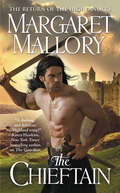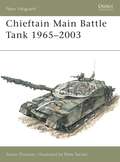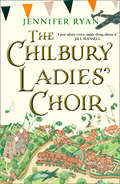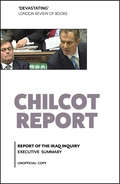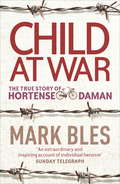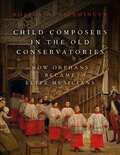- Table View
- List View
The Chiefs Now in This City: Indians and the Urban Frontier in Early America
by Colin CallowayDuring the years of the Early Republic, prominent Native leaders regularly traveled to American cities--Albany, Boston, Charleston, Philadelphia, Montreal, Quebec, New York, and New Orleans--primarily on diplomatic or trade business, but also from curiosity and adventurousness. They were frequently referred to as "the Chiefs now in this city" during their visits, which were sometimes for extended periods of time. Indian people spent a lot of time in town. Colin Calloway, National Book Award finalist and one of the foremost chroniclers of Native American history, has gathered together the accounts of these visits and from them created a new narrative of the country's formative years, redefining what has been understood as the "frontier." Calloway's book captures what Native peoples observed as they walked the streets, sat in pews, attended plays, drank in taverns, and slept in hotels and lodging houses. In the Eastern cities they experienced an urban frontier, one in which the Indigenous world met the Atlantic world. Calloway's book reveals not just what Indians saw but how they were seen. Crowds gathered to see them, sometimes to gawk; people attended the theatre to watch "the Chiefs now in this city" watch a play. Their experience enriches and redefines standard narratives of contact between the First Americans and inhabitants of the American Republic, reminding us that Indian people dealt with non-Indians in multiple ways and in multiple places. The story of the country's beginnings was not only one of violent confrontation and betrayal, but one in which the nation's identity was being forged by interaction between and among cultures and traditions.
The Chieftain (The Return of the Highlanders #4)
by Margaret MalloryConnor, chieftain of the MacDonalds of Sleat, holds the fate of his people in his hands. Rival clans are plotting to take over his lands, and duty determines whom he will fight, trust . . . even marry. Seeking guidance, Connor turns to Ilysa, a young lass with the gift of foresight, who reveals an approaching danger-and a passion that burns only for him. But the warrior must make a powerful marriage alliance, and Ilysa's bloodline is far too humble. With her powers to heal and see evil where others cannot, beautiful Ilysa dresses plainly, speaks softly, and loves her chieftain from afar. Yet when Connor finally stokes the embers of desire that have so long burned within her, Ilysa feels bliss unlike any she's ever known. Now as he is forced to place duty before happiness, Ilysa senses Connor is in grave peril. Can she find a way to prove she is the woman he needs by his side?
The Chieftain: Victorian True Crime Through the Eyes of a Scotland Yard Detective (History Press Ser.)
by Chris PayneGeorge Clarke joined the Metropolitan Police in 1841. Though a "slow starter," his career took off when he was transferred to the small team of detectives at Scotland Yard in 1862, where he became known as "The Chieftain." This book paints the most detailed picture yet published of detective work in mid-Victorian Britain, covering "murders most foul," "slums and Society," the emergence of terrorism related to Ireland, and Victorian frauds. One particular fraudster, Harry Benson, was to contribute to the end of Clarke's career and lead to the first major Metropolitan Police corruption trial in 1877. This fascinating book uses widespread sources of information, including many of Clarke's own case reports.
Chieftain Main Battle Tank 1965–2003 (New Vanguard)
by Peter Sarson Simon DunstanThe concept of the Main Battle Tank emerged from the Centurion Universal tank that was developed at the end of World War II. Development of its successor began as early as 1951. The Chieftain incorporated significant innovations including a reclining driver position and two-piece ammunition for greater survivability. The tank entered service in 1967 and was the heaviest armed and armoured MBT within the NATO alliance. The Chieftain saw combat during the Iran-Iraq War, with the Kuwaitis during the 1990 Iraqi invasion and with the British Army during the Gulf War of 1990–91 as special-purpose variants. This book explores the design, development and operation of one of the most influential vehicles used in modern warfare.
Chieftain Main Battle Tank 1965–2003 (New Vanguard #80)
by Peter Sarson Simon DunstanThe concept of the Main Battle Tank emerged from the Centurion Universal tank that was developed at the end of World War II. Development of its successor began as early as 1951. The Chieftain incorporated significant innovations including a reclining driver position and two-piece ammunition for greater survivability. The tank entered service in 1967 and was the heaviest armed and armoured MBT within the NATO alliance. The Chieftain saw combat during the Iran-Iraq War, with the Kuwaitis during the 1990 Iraqi invasion and with the British Army during the Gulf War of 1990–91 as special-purpose variants. This book explores the design, development and operation of one of the most influential vehicles used in modern warfare.
Chienne de Guerre: A Woman Reporter Behind the Lines of the War in Chechnya
by Anne NivatTwo years ago, when she was thirty years old, Anne Nivat decided to see first-hand what war was all about. Russia had just launched its second brutal campaign against Chechnya. And though the Russians strictly forbade Westerners from covering the war, the aspiring French journalist decided she would go. There are two very real dangers in Chechnya: being arrested by the Russians and being kidnapped by the Chechens. Nivat strapped her satellite phone to her belly, disguised herself in the garb of a Chechen peasant, and sneaked across the border. She found a young guide, Islam, to lead her illegally through the war zone. For six months they followed the war, travelling with underground rebels and sleeping with Chechen families or in abandoned buildings. Anne trembled through air raids; walked through abandoned killing fields; and helped in the halls of bloody hospitals. She interviewed rebel leaders, government officials, young widows, and angry fighters, and she reported everything back to France. Her reports in Libération led to antiwar demonstrations outside the Russian embassy in Paris. Anne's words move. They are not florid, but terse, cool, dramatic. More than just a war correspondent's report, Chienne de Guerre is a moving story of struggle and self-discovery-the adventures of one young woman who repeatedly tests her own physical and psychological limits in the extremely dangerous and stressful environment of war.
The Chilbury Ladies’ Choir: A Novel
by Jennifer Ryan‘The writing glows with emotional intelligence. This atmospheric debut…had me sniffing copiously’ Daily Mail
Chilcot Report: Executive Summary
by Sir John Chilcot Sir Lawrence Freedman Sir Roderic Lyne Sir Martin Gilbert Baroness Usha Kumari Prashar Iraq InquiryAll the key findings of the public inquiry into the handling of the 2003 Iraq war by Tony Blair's government in a 60,000-word book. Chaired by Sir John Chilcot, the Iraq Inquiry (known as the 'Chilcot Report') tackled: Saddam Hussein's threat to Britain the legal advice for the invasion intelligence about weapons of mass destruction and planning for a post-conflict Iraq. The behaviour of the GCHQ whistleblower Katharine Gun and the controversy over whether Iraq had weapons of mass destruction formed the subject of the political thriller Official Secrets. Reviews It offers a long and painful account of an episode that may come to be seen as marking the moment when the UK fell off its global perch, trust in government collapsed and the country turned inward and began to disintegrate. (Philippe Sands, London Review of Books) Chilcot has confirmed that... we still do not have intelligent long-range planning by the armed forces in close and active cooperation with other government agencies, nor an adequate and integrated system for the collection and evaluation of intelligence information, nor do we have the highest possible quality and stature of personnel to lead us through these challenging times. (Derek B. Miller, The Guardian) Although sceptics wondered how much more the very-long-awaited Report of the Iraq Inquiry by a committee chaired by Sir John Chilcot could tell us when it appeared at last in July, it proves to contain a wealth of evidence and acute criticism, the more weighty for its sober tone and for having the imprimatur of the official government publisher. (Geoffrey Wheatcroft, The New York Review of Books) Contents Introduction Pre-conflict strategy and planning The UK decision to support US military action Why Iraq? Why now? The UK's relationship with the US Decision-making Advice on the legal basis for military action Weapons of mass destruction Planning for a post-Saddam Hussein Iraq The post-conflict period Occupation Transition Planning for withdrawal Did the UK achieve its objectives in Iraq? Key findings Lessons Timeline of events EXTRACT: The gap between the Permanent Members of the Security Council widens 162. In their reports to the Security Council on 14 February: • Dr Blix reported that UNMOVIC had not found any weapons of mass destruction and the items that were not accounted for might not exist, but Iraq needed to provide the evidence to answer the questions, not belittle them. • Dr Mohamed ElBaradei, Director General of the International Atomic Energy Agency (IAEA), reported that the IAEA had found no evidence of ongoing prohibited nuclear or nuclear‐related activities in Iraq although a number of issues were still under investigation. 163. In the subsequent debate, members of the Security Council voiced widely divergent views. 164. Mr Annan concluded that there were real differences on strategy and timing in the Security Council. Iraq’s non‐co‐operation was insufficient to bring members to agree that war was justified; they would only move if they came to their own judgement that inspections were pointless. 165. On 19 February, Mr Blair sent President Bush a six‐page Note. He proposed focusing on the absence of full co‐operation and a “simple” resolution stating that Iraq had failed to take the final opportunity, with a side statement defining tough tests of co‐operation and a vote on 14 March to provide a deadline for action. 166. President Bush and Mr B
Child Actors on the London Stage, Circa 1600: Their Education, Recruitment and Theatrical Success
by Julie AckroydA legal document dated 1600, for a Star Chamber case titled Clifton versus Robinson, details how boys were abducted from London streets and forcibly held in order to train them as actors for the Blackfriars theatre. No adults were seen on-stage in this theatre, which was stocked solely by acting boys, resulting in a satirical and scurrilous method of play presentation. Were the boys specifically targeted for skills they may have possessed which would have been applicable to this type of play presentation? And, was this method of recruitment typical or atypical of Elizabethan theatre? Analysis of the background of the boy subjects of the legal case indicate that several had received grammar-school tuition and, as a result, would have possessed skills in oration and rhetoric. Indeed, a significant number of the grammar schools in London provided regular public disputations and theatrical performances which would have made these boys an attractive proposition for inclusion in a theatrical company. The styles of play-texts which the boys performed and their manner of presenting characters helps to assess why child acting companies were commercially viable and popular. Their portrayal of all roles in a performance; young and old, male and female, clearly demonstrated their versatility and skill in mimicry and the adoption of other personas. Therefore the taking of grammar-school boys for re-training as actors was not opportunistic; their abductions were planned. The theatre owners undertook this method of recruitment as they felt that they were immune from prosecution due to holding royal commissions which they used to recruit boys. However, the Clifton vs. Robinson case clearly demonstrates that a determined parent whose child had been taken could challenge this and demand reparation.
The Child and the State in India: Child Labor and Education Policy in Comparative Perspective
by Myron WeinerIndia has the largest number of non-schoolgoing working children in the world. Why has the government not removed them from the labor force and required that they attend school, as have the governments of all developed and many developing countries? To answer this question, this major comparative study first looks at why and when other states have intervened to protect children against parents and employers. By examining Europe of the nineteenth century, the United States, Japan, and a number of developing countries, Myron Weiner rejects the argument that children were removed from the labor force only when the incomes of the poor rose and employers needed a more skilled labor force. Turning to India, the author shows that its policies arise from fundamental beliefs, embedded in the culture, rather than from economic conditions. Identifying the specific values that elsewhere led educators, social activists, religious leaders, trade unionists, military officers, and government bureaucrats to make education compulsory and to end child labor, he explains why similar groups in India do not play the same role.
The Child and the State in India: Child Labor and Education Policy in Comparative Perspective
by Myron WeinerIndia has the largest number of non-schoolgoing working children in the world. Why has the government not removed them from the labor force and required that they attend school, as have the governments of all developed and many developing countries? To answer this question, this major comparative study first looks at why and when other states have intervened to protect children against parents and employers. By examining Europe of the nineteenth century, the United States, Japan, and a number of developing countries, Myron Weiner rejects the argument that children were removed from the labor force only when the incomes of the poor rose and employers needed a more skilled labor force. Turning to India, the author shows that its policies arise from fundamental beliefs, embedded in the culture, rather than from economic conditions. Identifying the specific values that elsewhere led educators, social activists, religious leaders, trade unionists, military officers, and government bureaucrats to make education compulsory and to end child labor, he explains why similar groups in India do not play the same role.
Child At War: The True Story of Hortense Daman
by Mark Whitcombe-PowerAt the age of fifteen Hortense Daman embarked on a secret career. In her German-occupied hometown of Louvain, Belgium, she joined the resistance, first as a courier, then as a fighter. She ran terrifying risks, smuggling explosives in her bicycle pannier past German soldiers and helping allied airmen to safety. It couldn't last; and it didn't. She was later betrayed, imprisoned and condemned to death. Separated from her family, she - and later her mother - was sent to the 'women's inferno' - Ravensbruck concentration camp. Subjected to horrific medical experiments, she endured starvation, illness, freezing temperatures, and she watched helplessly as thousands died around her. Yet, against unimaginable odds, she survived. Child at War is the true, extraordinary and often shocking account of the years that saw Hortense change from the innocent schoolgirl to freedom fighter and ultimately to survivor of the most atrocious regime the world has ever seen.
Child Composers in the Old Conservatories: How Orphans Became Elite Musicians
by Robert O. GjerdingenIn seventeenth century Italy, overcrowding, violent political uprising, and plague led an astonishing number of abandoned and orphaned children to overwhelm the cities. Out of the piety of private citizens and the apathy of local governments, the system of conservatori was created to house, nurture, and train these fanciulli vaganti (roaming children) to become hatters, shoemakers, tailors, goldsmiths, cabinet makers, and musicians - a range of practical trades that might sustain them and enable them to contribute to society. Conservatori were founded across Italy, from Venice and Florence to Parma and Naples, many specializing in a particular trade. Four music conservatori in Naples gained particular renown for their exceptional training of musicians, both performers and composers, all boys. By the eighteenth century, the graduates of the Naples conservatories began to spread across Europe, with some 600 boys formerly in residence beginning to dominate the European musical world. Other conservatories in the country - including the Paris Conservatory - began to imitate the principles of the Naples' conservatory's training, known as the partimento tradition. The daily lessons and exercises associated with this tradition were largely lost-until author Robert Gjerdingen discovered evidence of them in the archives of conservatories across Italy and the rest of Europe. Compellingly narrated and richly illustrated, Child Composers in the Old Conservatory follows the story of these boys as they undergo rigorous training with the conservatory's maestri and eventually become maestri themselves, then moves forward in time to see the influence of partimenti in the training of such composers as Claude Debussy and Colette Boyer. Advocating for the revival of partimenti in modern music education, the book explores the tremendous potential of this tradition to enable natural musical fluency for students of all ages learning the craft today.
Child Composers in the Old Conservatories: How Orphans Became Elite Musicians
by Robert O. GjerdingenIn seventeenth century Italy, overcrowding, violent political uprising, and plague led an astonishing number of abandoned and orphaned children to overwhelm the cities. Out of the piety of private citizens and the apathy of local governments, the system of conservatori was created to house, nurture, and train these fanciulli vaganti (roaming children) to become hatters, shoemakers, tailors, goldsmiths, cabinet makers, and musicians - a range of practical trades that might sustain them and enable them to contribute to society. Conservatori were founded across Italy, from Venice and Florence to Parma and Naples, many specializing in a particular trade. Four music conservatori in Naples gained particular renown for their exceptional training of musicians, both performers and composers, all boys. By the eighteenth century, the graduates of the Naples conservatories began to spread across Europe, with some 600 boys formerly in residence beginning to dominate the European musical world. Other conservatories in the country - including the Paris Conservatory - began to imitate the principles of the Naples' conservatory's training, known as the partimento tradition. The daily lessons and exercises associated with this tradition were largely lost-until author Robert Gjerdingen discovered evidence of them in the archives of conservatories across Italy and the rest of Europe. Compellingly narrated and richly illustrated, Child Composers in the Old Conservatory follows the story of these boys as they undergo rigorous training with the conservatory's maestri and eventually become maestri themselves, then moves forward in time to see the influence of partimenti in the training of such composers as Claude Debussy and Colette Boyer. Advocating for the revival of partimenti in modern music education, the book explores the tremendous potential of this tradition to enable natural musical fluency for students of all ages learning the craft today.
A Child for Keeps: The History of Adoption in England, 1918-45
by J. KeatingThe history of adoption from 1918-1945, detailing the rise of adoption, the growth of adoption societies and considering the increasing emphasis on secrecy in adoption. Analyses adoption law from legalization in 1926, to regulation and reform in the 1930s, with regulations finally being enforced in 1943 amid concern about casual wartime adoptions.
A Child for the Reich
by Andie NewtonFrom the USA Today bestselling author comes a gripping new emotional WW2 historical novel. Inspired by a true story! ‘Easily my favorite historical novel of the year If you love WWII fiction, this is a must read’ Soraya M. Lane, Amazon Charts bestselling author of Wives of War and The Last Correspondent
Child From Home: Memories of a North Country Evacuee
by John WrightIn 1939, John Wright, a four-year-old boy from a deprived but loving Middlesbrough home, was uprooted from his family and evacuated to a large house in North Yorkshire, requisitioned as a nursery school. His story is not unlike any other during the upheaval of wartime, but in this remarkably lucid and detailed set of recollections, a seventy-three-year-old man tells his story of love, loss and life with the delight and fear of a wartime child. His poignant memories of cruelty and hurt are set against a beautiful voyage of discovery as a young boy explores the Yorkshire countryside and comes of age in a unique environment, only to be struck by an unbearable tragedy. A bittersweet tale of innocence and stark realities, Child from Home explores why wartime means so much to our collective memory - and reveals the devastating effect we have on children as we try to protect them from conflict.
The Child from the Ash Pits: A heartbreaking saga
by Chrissie WalshIn the aftermath of the General Strike, times are tough for coal miners and their families. Can little Cally break free from poverty, and forge a successful life for herself? When Cally loses her beloved mum, she hopes her father will comfort and protect her. But instead she soon acquires a cruel and vengeful stepmother, and Cally begins to fear that she is on her own. Through uncomfortable years in service, to a terrifying brush with the streets, through hard work and determination, Cally finally finds a place for herself. She even trusts enough in the future to create her own family, despite being so cruelly abandoned by her own. At last in a place of peace and contentment, Cally has all she ever hoped for, but with World War 2 looming, how long can she hold on to the people she loves? Taking us from 1926 all the way to end of the Second World War, Chrissie Walsh has written a heart-breaking tale of love and survival, perfect for fans of Dilly Court and Lyn Andrews. Praise for The Child from the Ash Pits: 'Full of joy, sorrow and a big pinch of fun. I loved it' Elizabeth Gill. 'A captivating story of family, relations and the complexities of life. With truly heart-tugging moments that make you shed a tear. The Child from the Ash Pits is everything a good read should be' Diane Allen.
Child Guidance in Britain, 1918–1955: The Dangerous Age of Childhood (Studies for the Society for the Social History of Medicine)
by John StewartStewart presents a history of child guidance in Britain from its origins in the years after the First World War until the consolidation of the welfare state. This is the first study of child guidance in this period and makes a significant contribution to the historiography.
Child Guidance in Britain, 1918–1955: The Dangerous Age of Childhood (Studies for the Society for the Social History of Medicine #12)
by John StewartStewart presents a history of child guidance in Britain from its origins in the years after the First World War until the consolidation of the welfare state. This is the first study of child guidance in this period and makes a significant contribution to the historiography.
The Child in Cinema
by Karen LuryThis book brings together a host of internationally recognised scholars to provide an interdisciplinary perspective on the representation of the child in cinema. Individual chapters examine how children appear across a broad range of films, including Badlands (1973), Ratcatcher (1999), Boyhood (2014), My Neighbour Totoro (1988), and Howl's Moving Castle (2004). They also consider the depiction of children in non-fiction and non-theatrical films, including the documentaries Être et Avoir (2002) and Capturing the Friedmans (2003), art installations and public information films. Through a close analysis of these films, contributors examine the spaces and places children inhabit and imagine; a concern for children's rights and agency; the affective power of the child as a locus for memory and history; and the complexity and ambiguity of the child figure itself.The essays also argue the global reach of cinema featuring children, including analyses of films from the former Yugoslavia, Brazil and India, as well as exploring the labour of the child both in front of and behind the camera as actors and filmmakers. In doing so, the book provides an in-depth look into the nature of child performance on screen, across a diverse range of cinemas and film-making practices.
The Child in Cinema
by Karen LuryThis book brings together a host of internationally recognised scholars to provide an interdisciplinary perspective on the representation of the child in cinema. Individual chapters examine how children appear across a broad range of films, including Badlands (1973), Ratcatcher (1999), Boyhood (2014), My Neighbour Totoro (1988), and Howl's Moving Castle (2004). They also consider the depiction of children in non-fiction and non-theatrical films, including the documentaries Être et Avoir (2002) and Capturing the Friedmans (2003), art installations and public information films. Through a close analysis of these films, contributors examine the spaces and places children inhabit and imagine; a concern for children's rights and agency; the affective power of the child as a locus for memory and history; and the complexity and ambiguity of the child figure itself.The essays also argue the global reach of cinema featuring children, including analyses of films from the former Yugoslavia, Brazil and India, as well as exploring the labour of the child both in front of and behind the camera as actors and filmmakers. In doing so, the book provides an in-depth look into the nature of child performance on screen, across a diverse range of cinemas and film-making practices.
The Child in Film: Tears, Fears and Fairy Tales (Rutgers Series In Childhood Studies)
by Karen LuryGhastly and ghostly children, 'dirty little white girls', the child as witness and as victim, have always played an important part in the history of cinema, as have child performers themselves. In exploring the disruptive power of the child in films made for an adult audience across popular films, including 'Taxi Driver' and Japanese horror, and 'arthouse' productions like 'Mirror' and 'Pan's Labyrinth', Karen Lury investigates why the figure of the child has such a significant impact on the visual aspects and storytelling potential of cinema. Lury's main argument is that the child as a liminal yet powerful agent has allowed filmmakers to play adventurously with cinema's formal conventions with farreaching consequences. In particular, she reveals how a child's relationship to time allows it to disturb and question conventional masternarratives. She explores too the investment in the child actor and expression of child sexuality, as well as how confining and conservative existing assumptions can be in terms of commonly held beliefs as to who children 'really are'.
The child in Spanish cinema (G - Reference, Information And Interdisciplinary Subjects Ser.)
by Sarah WrightIn this, the first full-length treatment of the child in Spanish cinema, Sarah Wright explores the ways that the cinematic child comes to represent ‘prosthetic memory’. The central theme of the child and the monster is used to examine the relationship of the self to the past, and to cinema. Concentrating on films from the 1950s to the present day, the book explores religious films, musicals, ‘art-house horror’, science-fiction, social realism and fantasy. It includes reference to Erice’s The Spirit of The Beehive, del Toro’s Pan’s Labyrinth, Mañas’s El Bola and the Marisol films. The book also draws on a century of filmmaking in Spain and intersects with recent revelations concerning the horrors of the Spanish past. The child is a potent motif for the loss of historical memory and for its recuperation through cinema. This book is suitable for scholars and undergraduates working in the areas of Spanish cinema, Spanish cultural studies and cinema studies.

